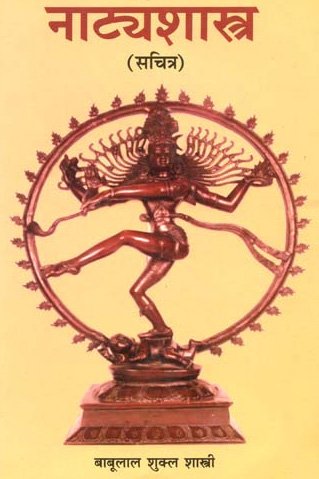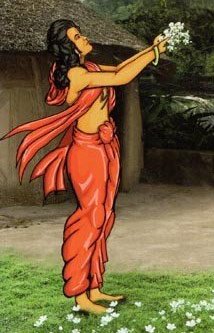Urdhvaka, Ūrdhvaka: 9 definitions
Introduction:
Urdhvaka means something in Hinduism, Sanskrit, Jainism, Prakrit. If you want to know the exact meaning, history, etymology or English translation of this term then check out the descriptions on this page. Add your comment or reference to a book if you want to contribute to this summary article.
In Hinduism
Natyashastra (theatrics and dramaturgy)
Source: Wisdom Library: Nāṭya-śāstraŪrdhvaka (ऊर्ध्वक) refers to a type of drum (puṣkara) according to the Nāṭyaśāstra chapter 33. Accordingly, “the aṅkī or āṅkika is like a myrobalan. and the ūrdhvaka is like a barley, and the āliṅgya resembles a cow’s tail. And the ūrdhvaka should be four tālas long and its face should be fourteen fingers in diametre”.

Natyashastra (नाट्यशास्त्र, nāṭyaśāstra) refers to both the ancient Indian tradition (shastra) of performing arts, (natya—theatrics, drama, dance, music), as well as the name of a Sanskrit work dealing with these subjects. It also teaches the rules for composing Dramatic plays (nataka), construction and performance of Theater, and Poetic works (kavya).
Kavya (poetry)
Source: archive.org: Naisadhacarita of SriharsaŪrdhvaka (ऊर्ध्वक) refers to a “kind of drum”, and is mentioned in the Naiṣadha-carita 7.66. Ūrdhvaka is defined as yavamadhyastathordhvakaḥ.

Kavya (काव्य, kavya) refers to Sanskrit poetry, a popular ancient Indian tradition of literature. There have been many Sanskrit poets over the ages, hailing from ancient India and beyond. This topic includes mahakavya, or ‘epic poetry’ and natya, or ‘dramatic poetry’.
In Jainism
General definition (in Jainism)
Source: archive.org: TrisastisalakapurusacaritraŪrdhvaka (ऊर्ध्वक) or Ūrdhvakamṛdaṅga is one of three kinds of mṛdaṅgas—aṅki, āliṅgī, and ūrdhvaka.—(cf. Abhidhānacintāmaṇi 2.207 and commetary).—(Cf. also Nāṭyaśāstra XXXIII).

Jainism is an Indian religion of Dharma whose doctrine revolves around harmlessness (ahimsa) towards every living being. The two major branches (Digambara and Svetambara) of Jainism stimulate self-control (or, shramana, ‘self-reliance’) and spiritual development through a path of peace for the soul to progess to the ultimate goal.
Languages of India and abroad
Sanskrit dictionary
Source: DDSA: The practical Sanskrit-English dictionaryŪrdhvaka (ऊर्ध्वक).—A kind of drum (Mar. tabalā).
Derivable forms: ūrdhvakaḥ (ऊर्ध्वकः).
See also (synonyms): ūrddhaka.
Source: Cologne Digital Sanskrit Dictionaries: Cappeller Sanskrit-English DictionaryŪrdhvaka (ऊर्ध्वक).—[adjective] raised; [neuter] [adverb] loud.*
Source: Cologne Digital Sanskrit Dictionaries: Monier-Williams Sanskrit-English Dictionary1) Ūrdhvaka (ऊर्ध्वक):—[from ūrdhva] mfn. raised, lifted up, [Saṃnyāsa-upaniṣad]
2) [v.s. ...] m. a kind of drum, [Naiṣadha-carita]
[Sanskrit to German]
Sanskrit, also spelled संस्कृतम् (saṃskṛtam), is an ancient language of India commonly seen as the grandmother of the Indo-European language family (even English!). Closely allied with Prakrit and Pali, Sanskrit is more exhaustive in both grammar and terms and has the most extensive collection of literature in the world, greatly surpassing its sister-languages Greek and Latin.
Kannada-English dictionary
Source: Alar: Kannada-English corpusŪrdhvaka (ಊರ್ಧ್ವಕ):—[noun] a kind of drum, a percussion instrument.
Kannada is a Dravidian language (as opposed to the Indo-European language family) mainly spoken in the southwestern region of India.
See also (Relevant definitions)
Starts with: Urdhvakaca, Urdhvakacha, Urdhvakam, Urdhvakamridanga, Urdhvakanta, Urdhvakantha, Urdhvakanthaka, Urdhvakapala, Urdhvakara, Urdhvakarman, Urdhvakarna, Urdhvakaya.
Ends with: Murdhvaka.
Full-text: Urdha, Urdhvakam, Anki, Urdhvakamridanga, Urddhaka, Alingi, Ankimridanga, Airavana, Urdhvagoshthika, Vilepana, Alingya, Paryaya, Deshadapetarupa, Ankika, Vitasta, Alipta, Svati, Alingimridanga.
Relevant text
Search found 5 books and stories containing Urdhvaka, Ūrdhvaka; (plurals include: Urdhvakas, Ūrdhvakas). You can also click to the full overview containing English textual excerpts. Below are direct links for the most relevant articles:
Natyashastra (English) (by Bharata-muni)
Amarakoshodghatana of Kshirasvamin (study) (by A. Yamuna Devi)
Musical instruments (e.g., Stringed, Percussions, Cymbals and Wind-blown) < [Chapter 4 - Cultural Aspects]
Gati in Theory and Practice (by Dr. Sujatha Mohan)
References to drama, dance and music in Sanskrit literature < [Chapter 1 - Nāṭya]
The Agni Purana (by N. Gangadharan)
Naishadha-charita of Shriharsha (by Krishna Kanta Handiqui)